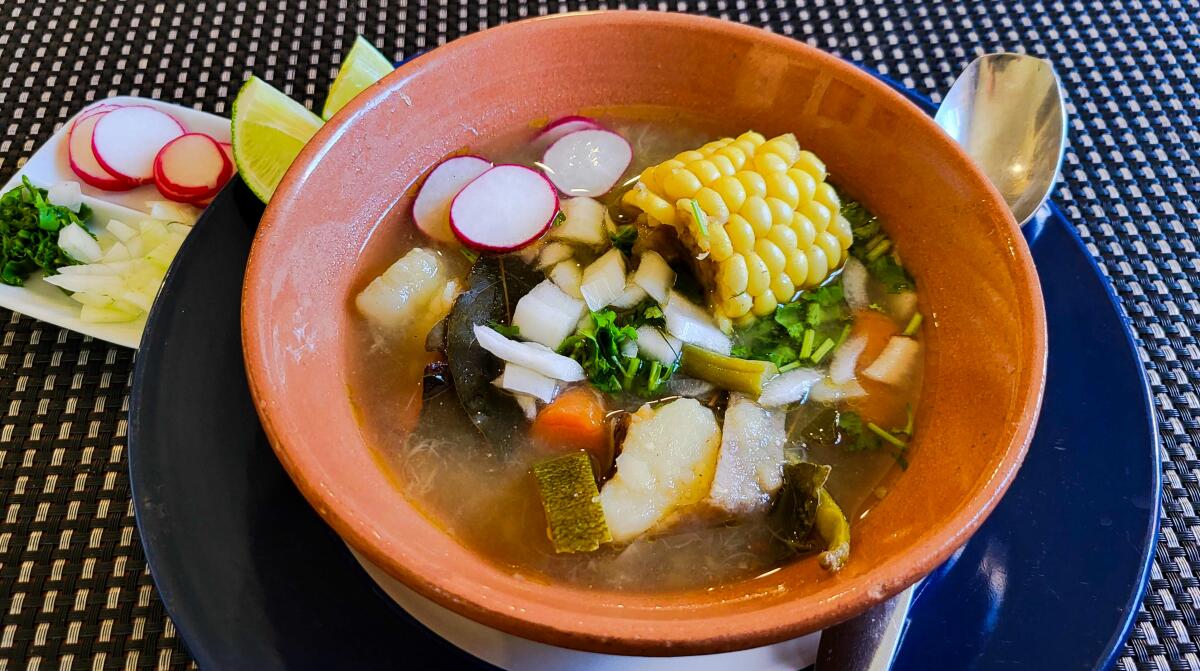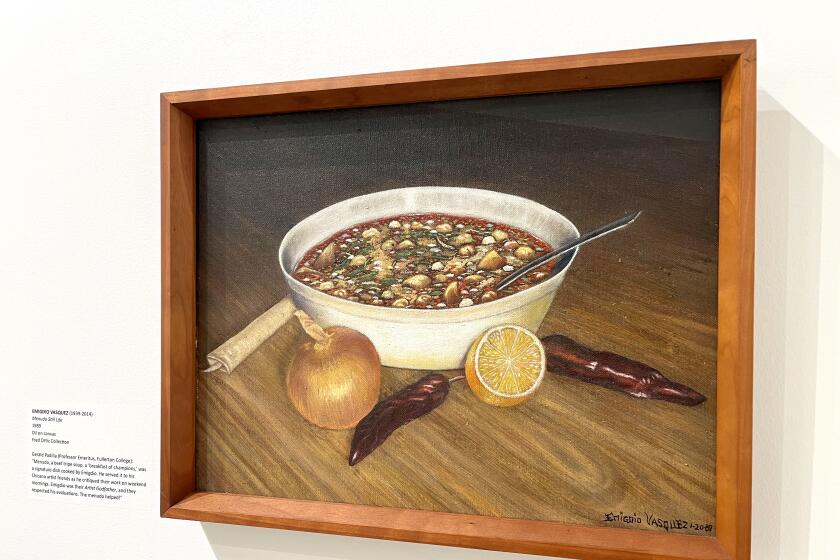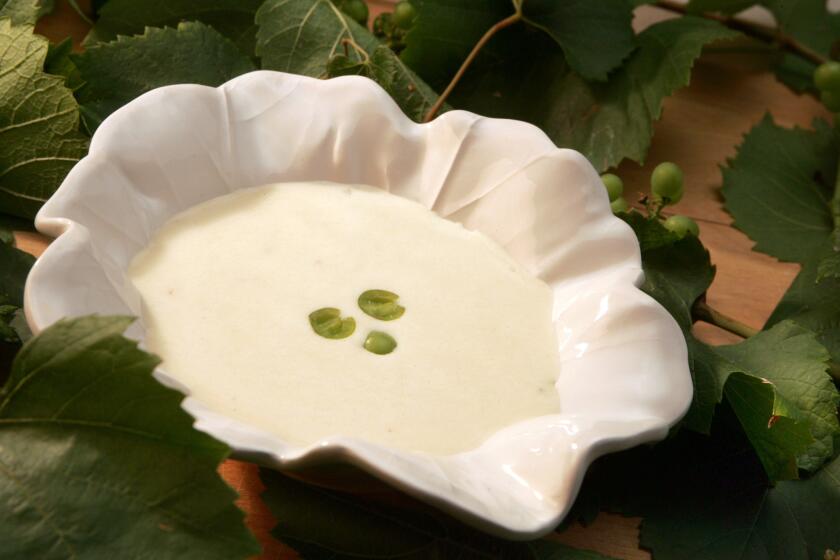A hearty beef stew with an L.A. touch to survive the spring

- Share via
You are reading our Cooking newsletter
Sign up to get a taste of Los Angeles — and the world — in your own home and in your inbox every Sunday
You may occasionally receive promotional content from the Los Angeles Times.
Did you all notice how radiantly sunny it was outside for a few days recently?
On Monday and Tuesday it felt like the sun was letting it all shine. All flora outside seemed to flicker with its rays. Then the second half of the week brought clouds and cold again, and — shrug — that’s actually how spring does its thing in Southern California: dramatic swings between moisture, gloominess and sunlight. One thing that remains constant though is an unacknowledged truth: It is actually chilly all through spring in our region, rain or sunshine.
Spring in L.A. is actually a great time for soups. That’s why I found myself digging around for a beef stew recipe in recent days. I was inspired partly by a few ingredients that had been eyeing me for days: a potato on the counter, some farmer’s market carrots and about a pound of mini-diced chuck beef from Trader Joe’s in the freezer. I could make a caldo de res, I thought.
Caldo de res or Mexican beef stew is about homeyness, remedy and renewal. I wanted to make something that would conjure the bowls of piping hot caldo de res you might be drawn to on a chilly night at a little fonda somewhere in Mexico. It would be a clearish beef broth piled with confident pieces of potato, carrot, corn and chayote, dressed with fresh cilantro and maybe chopped onion and a squeeze of lime.
Versions of the caldo or sopa de res are common across Mexico, in Central America and the Caribbean, as well as in Colombia, Venezuela, Ecuador and pretty much to the end of Patagonia. In Spain, it’s known as puchero, in reference to the large pot customarily used to cook it. And well, there’s Irish stew, beef bourguignon and so on, moving deeper into the stew category.
Mexican cuisine comfort soup recipes inspired by the menudo still life at the newly reopened Hilbert Museum of California Art.
In our archive at The Times, I came across a beef stew with chayotes recipe by former longtime Times staff writer Lorenza Muñoz, published in 2012, that seemed most approximate to what I wanted to eat. The writer says her mother called it puchero and was more European-influenced. The recipe features a proper amount of brandy, an ingredient I had never before associated with a caldo de res. Luckily, I had a nearly empty bottle of brandy left from my ponche-making days in December.
My closest Latin market did not have chayote when I popped in (it’s also not in season), so I grabbed some calabazas and loose green beans, plus loaded up on onion and serrano chile; for my style of garnishing later. The stew recipe calls for beef bone, but at two stores I couldn’t find any, so I figured I would add 3 beef boullion cubes instead of 2 to rally the flavor.
And — since I can’t help myself when it comes to chiles and also because I am an Angeleno — I added about half a serrano chile, with seeds, just before the boil began. I wanted this soup to greet every sip with a bite of spice. One lucky eater will get a solid bite of boiled serrano in their soup bowl and come close to touching the heaven of heat, I thought.
As for the brandy, Muñoz’s recipe calls for ¼ cup of it. It goes in early as the beef cubes cook. But when I emptied my bottle, nearly half a cup came out, and I figured I’d just use it all. As the water came in for the first hour of simmering, I also added a few hard dashes of our L.A. Times Food dry chili crisp California Heat, in collaboration with Burlap & Barrel — like I do with almost anything I cook these days, it’s pretty addictive.

Almost three hours later, my modified caldo de res was ready. It was without beef on the bone, but still felt nourishing and hearty. No chayote, but the calabazas did the trick. My broth was slightly foggy brown, but still transparent, and had a touch of warming sweetness from the brandy that contrasted with the spice. The deeper textures here might throw you off if you are expecting a glassier caldo de res like they serve up in the sierras of Mexico, but it all still works.
For garnishing, I cut coarse pieces of onion and cilantro, plus discs of fresh serrano and radish on top, with wedges of lime. The hunk of corn poking out like a mountain on the soup’s surface is a familiar wonder. There was no birote at night anywhere, so a cheap Italian loaf from the supermarket rounded off the meal. Or have tortillas.
For years, I’ve found myself making seafood soups more often in the rainy season or winter in Southern California. My super-spicy Mexican-style shrimp soup got me through the pandemic shutdowns. As of this week, I think I’m a changed cook. I’ll be making this modified Angeleno springtime caldo de res my new go-to for chilly nights until summer.
Below are a couple other intriguing regional stews or soups drawing me into The Times’ vast archive as April settles in. And if you cook an improvised version of Lorenza Muñoz’s beef stew with chayotes, let us know how it goes!
Sometimes nothing beats the heat better than a bowl of chilled soup.
Eating out this week? Sign up for Tasting Notes to get our restaurant experts’ insights and off-the-cuff takes on where they’re dining right now.
Beef Stew With Chayotes
A proper cross-continental caldo de res-style stew with chayotes that combines influences from Eastern Europe, Spain and Mexico. This recipe calls for beef on the bone and brandy, which help deepen its texture and flavor. It is perfect for winter and spring nights in Southern California. Use calabaza or Mexican zucchini if you can’t find chayote.
Get the recipe.
Cook time: 3 hours.

Mexican Chicken Soup
Chicken soup is probably more common in Mexico than beef stew, since it is usually quicker and cheaper to make, and is more widely considered a home remedy for colds and flus. Most fondas serving set-price meals of “comida corrida” throughout the day will have a consomé de pollo as a baseline on their menus. Many cooks add rice or noodles to this soup, but I’ve always felt Mexican chicken soup simply doesn’t work without the presence of the humble cabbage.
Get the recipe.
Cook time: 2 hours, 45 minutes.
Enjoying this newsletter?
Consider becoming a Times subscriber.

Tomatillo Tortilla Soup
If you’re a purist when it comes to Mexican food, you should probably stay away from this tortilla soup. It is adapted from the late Sally Schmitt of the French Laundry. It asks for a pound and a half of tomatillos, whole cumin seeds and the juice of an orange. But if you’re open to an interpretation of Mexican tortilla soup from a pioneer of California cuisine, for context for your cooking brain, this soup offers a funky yet intriguing take on what tortilla soup can be.
Get the recipe.
Cook time: 45 minutes.
Have a cooking question?
Eat your way across L.A.
Get our weekly Tasting Notes newsletter for reviews, news and more.
You may occasionally receive promotional content from the Los Angeles Times.






